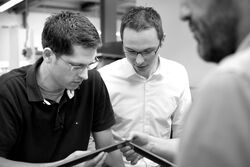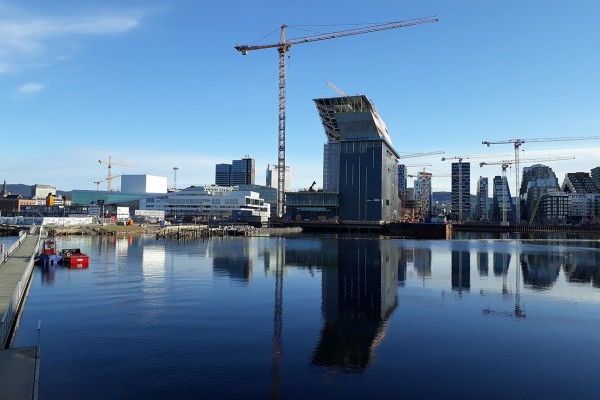HALBE an Werner Murrer equip the Munch Museum in Oslo
Kirchen, 27 Oct. 2021 - A few days ago, Norway finished the build of an architectural monument for its famous painter Edvard Munch – and HALBE frames was involved. The new Munch Museum is majestically enthroned on the Oslofjord and presents over 400 works by the expressionist on an area of 4,500 square meters. The relocation of the 42,000-object collection was a good opportunity to also reframe the valuable works of art. In addition to design considerations, the protection and security of the paintings played a decisive role. Together with the Munich specialist for contemporary frames, Werner Murrer, HALBE was awarded the contract for developing a non-visible interior frame that meets the highest conservation standards. Whether for the famous painting "The Scream" or "Puberty" - each frame was custom made for its artwork.
New Munch Museum: Paying homage to the artist
On 22 October, the new Munch Museum(www.munchmuseet.no) was inaugurated at the harbour - right next to the famous Oslo Opera House. The new building is five times the size of the old museum and presents more than 400 outstanding paintings, drawings and graphics by the Norwegian artist Edvard Munch (1863 - 1944) in eleven large halls. The museum preserves the entire estate, which consists not only of 26,700 works, but also of furnishings, slips of paper with poems and pieces of Munch's clothing. In his opening speech, King Harald emphasised: "All over the world, people have a relationship with Munch's art. In his paintings we recognise ourselves, our own light and dark sides."
Masterpieces newly framed
Nowhere else in the world is there such an abundance of works by an artist, which, from the very first painting when still a pupil to the very last, provides a complete picture of his artistic vita. Edvard Munch always kept the best pictures for himself. In contrast to the usual practice at the time, Edvard Munch did not use opulent gold frames for his works, but preferred to use plain round bar frames in a white or brown finish. To ensure that his paintings received the finishing touches from the forces of nature, he even stored his works and frames outside in the open air.
When the construction of the new museum began in 2015, the Munch Museum decided to reframe the important paintings to present them safely and securely to the world - especially in light of the fact that the museum had already been robbed twice during opening hours and recovered works were damaged.
HALBE-framing and Werner Murrer - a world-class framing team
Through their intensive study of Munch's original frames, the befriended companies Werner Murrer (www.murrer-rahmen.de) and HALBE (www.HALBE-rahmen.de) were awarded the contract for the development and production of the new Munch frames in an international tender. Both family businesses are experts in their field: the Munich frame workshop Werner Murrer enjoys world fame for contemporary frames. And the family business HALBE is among the world leaders in modern, high-quality magnetic frames, which enable the exhibits to be framed from the front for conservation purposes. An intelligent framing solution was created in close cooperation with the museum team.
HALBE manufactures the heart of the Munch frames
HALBE's core task was to design a stable inner frame that would permanently hold and protect the painting - from contact, harmful UV rays, dust and theft. In addition, it must meet the highest conservation requirements and allow for easy handling. Not an easy task for the experts from Western Germany, but one that can be solved.
In addition to meeting the high requirements, the works had to be prevented from coming into contact with the shatterproof Optium Museum Arcylic glass by the American company True Vue or the contemporary wooden outer frames by Werner Murrer. Also, no wood or wood-like material was to be used in the interior frame, as over the decades resin or tanning agents could leak out of the wood and permanently damage the valuable paintings.
Novel framing solution for the museum world
"As we are metal experts in connection with magnetic solutions, we pursued a different construction of the inner frame from the very beginning," says David Halbe, Managing Director of HALBE-Rahmen GmbH. "A completely new type of invisible inner frame was developed especially for the Munch Museum, and our magnetic frame was the inspiration for it." All the materials used were subjected to a special long-term test (ODDY test), ensuring both physically and chemically safe framing of the precious Munch works. In addition to the quick and safe framing, it is extremely practical for restorers that the frame is also accessible from the back through a removable rear panel. It is transparent and allows a rough visual check of the painting's condition.
"No matter if a small or large work of art by Edvard Munch - each frame was made individually for each painting. The original paintings were unfortunately not in our workshop for this purpose. No museum lets a frame maker touch its treasures. We only worked with the exact measurements of the museum team and were on site a few times," David Halbe emphasises. "In the development phase, we went incredibly deep into the material properties. Some of these findings have already been incorporated into the series production of our magnetic frames or are currently being implemented."

In 2015, work began on the new Munch Museum. Today, it sits majestically on the Oslofjord and presents over 400 works by the expressionist on an area of 4,500 square metres.

Whether the famous painting "The Scream" or "Puberty"- with the start of the museum's construction, the Munch Museum decided to reframe all the paintings to present them safely and securely to the world.

The Munch Museum presents over 400 works. No original was at HALBE for the adaptation of the new interior frame. The professionals worked with the exact measurements of the museum team.

During the entire development phase of the innovative interior frame, Heinrich and David Halbe (from left) were in Oslo several times to coordinate closely with the museum team.

HALBE developed a completely new invisible interior frame especially for the Munch Museum, which secures and protects the paintings so that they can be presented "correctly" in terms of technique and appearance.

The inner frame from HALBE has a removable rear panel on the back. It is transparent and allows conservators to make a rough visual check of the painting's condition at any time.

"During the development phase of the inner frame, we went into incredible depth about the material properties. Some of this knowledge has already been incorporated into the series production of our magnetic frames," emphasizes David Halbe (center).
We have compiled this and other high-resolution image material for you in the following dropbox - image rights: @HALBE Frames resp. @MURRER
https://www.dropbox.com/sh/xtf9x8clyw2aygg/AAAyIaqyRqKVeAcmWwb-qRj_a?dl=0
Reprint free of charge - Voucher copy requested



